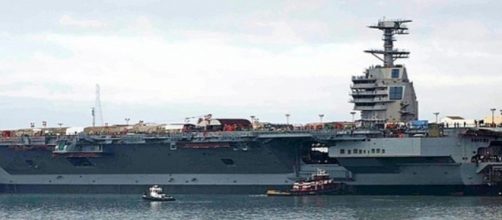President Donald Trump spoke at the commissioning ceremony of America’s latest super carrier, the USS Gerald R. Ford. He mentioned the need for increased and stable defense spending with a goal of, among other things, building a 350 ship navy, which military planners agree is necessary to project American power around the world. The Ford represents both the opportunity for maintaining America’s status as the greatest superpower on Earth and the difficulties of doing so.
The carrier is a technological marvel
The USS Gerald R. Ford, named after the 38th president of the United States, himself a World War II naval veteran, is a technological marvel.
She is equipped with an electromagnetic catapult system that can launch more and heavier aircraft faster than the old fashioned steam variety carriers have used in the past. Her control systems mean that 500 or fewer sailors are needed to operate her while at sea.
Ford’s commissioning comes at a time when a revolution in military weapons technology is taking place. Electromagnetic rail guns, capable of firing on targets hundreds of miles away, laser weapons that can take out targets at the speed of light, and drones that can perform missions which were previously undertaken by crewed aircraft, are combining to change the face of warfare. The Ford will likely be equipped with some of these weapons sometime during her 50-year service life.
The Ford suffered cost overruns and schedule slippages
Like too many big ticket military items, the USS Gerald R. Ford endured cost overruns and schedule slippages. Coming in at just under $13 billion, the Ford cost about 22 percent more than initially estimated, with $780 million more work needed before she becomes operational in 2021.
The Ford is 32 months behind schedule. The carrier still has navigation, cybersecurity, and software issues that must be resolved before she becomes an effective warship of the United States Navy.
Are carriers needed for the naval warfare of the future?
The Ford was commissioned against the backdrop of the periodic debate over the utility of big carriers for wars of the future.
She is, without a doubt, a formidable weapons system, with over 75 aircraft capable of delivering hurt to anywhere in the world. However, other countries, such as China and Russia, are developing hypersonic missiles and other carrier killing weapons that could place the survivability of these gigantic warships in doubt during wars of the future. Unless the technology is developed to defend carriers like the Ford from these new weapons, supercarriers could become expensive targets that will sail near a hostile coastline at their peril.


